#hon'ami kōetsu
Text

The Deer (detail) by Sōtatsu, 17th century.
1 note
·
View note
Photo

Poem by Kamo no Chōmei with Underpainting of Cherry Blossoms. Calligraphy by Hon'ami Kōetsu. Underpainting attributed to Tawaraya Sōtatsu. 1606
341 notes
·
View notes
Photo

“Akebonoya” waka poem. Calligraphy by Hon'ami Kōetsu, early 17th century, Japan
97 notes
·
View notes
Photo
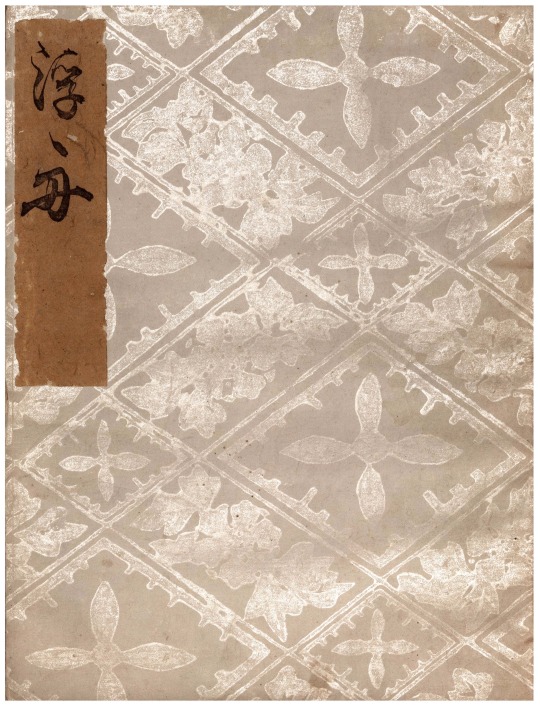
Kōetsu utai-bon (Nō libretto) [Saga, Kyoto, 1607] [Japan, Edo period, early 17th century] [National Museum of Asian Art, Smithsonian Institution, Washington, D.C.]
#art#calligraphy#visual writing#drawing#pattern#book#cover#book cover#tawaraya sōtatsu#hon'ami kōetsu#national museum of asian art#smithsonian institution#1600s
60 notes
·
View notes
Photo

Hon'ami Kōetsu, a central figure in Japanese art at the turn of the seventeenth century, revolutionized the visual effects of classical poetry scrolls, collaborating with other artists to produce striking images that complimented his distinctively bold calligraphy. In this scroll, Kōetsu brushed twelve love poems over gold and silver woodblock-printed designs of ivy, mehishiba (a type of crabgrass), and wisteria. On the reverse butterflies printed in gold and silver appear in random patterns, creating another visual layer as the scroll is unrolled.
"Poems from the Shinkokin wakashū," early 1600s, by Hon'ami Kōetsu
#Hon'ami Kōetsu#Japanese art#art#art museum#museum#national poetry month#poetry month#poetry#poem#poetry scrolls#Japan#scrolls#Japanese scrolls#calligraphy#poems#art history#history#Philadelphia Museum of Art#philadelphia#Philadelphia art museum#Philly museum of art#Philly art museum#Philly
295 notes
·
View notes
Photo
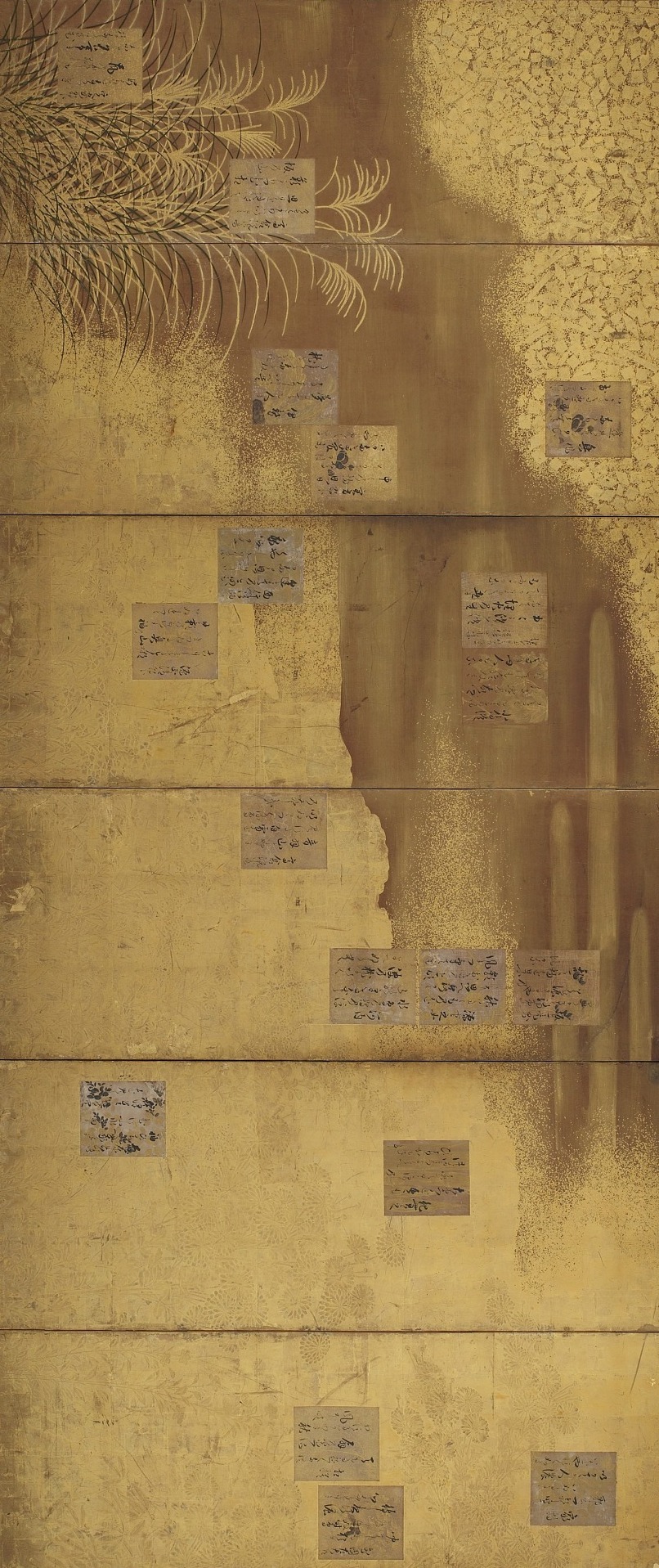

Folding screens, mounted with poems from the anthology Shin Kokinshu, by Hon'ami Kōetsu
Japanese, Edo Period, c. 1624-1637
ink, color, and gold on paper
Freer Gallery of Art
#The detail in the gold work is absolutely breathtaking if you're ever fortune enough to see these in person.#Asian art#Japanese art#Japan#Edo Period#screen#folding screen#art#art history#painting#Hon'ami Kōetsu#Freer Gallery of Art#Freer Sackler
49 notes
·
View notes
Photo




Imperial Anthology, Kokinshu 花鳥下絵和歌巻 (part 4 of 4)
Type: Handscroll
Artist: Tawaraya Sōtatsu 俵屋宗達 (fl. ca. 1600-1643)
Calligrapher: Hon'ami Kōetsu 本阿弥光悦 (1558-1637)
Historical period: Momoyama period, early 1600s
Medium: ink, gold, silver, and mica on paper
Geography: Japan
Freer Gallery of Art
80 notes
·
View notes
Photo

Butterflies and grasses ( Poetry sheet ).
Ink colour and gold on paper. Early 17th century.
Attributed to Hon'ami Kōetsu 本阿弥光悦
Image and text courtesy Freer Sackler. Japanese Art
Copyright with museum.
44 notes
·
View notes
Photo

Five Nō Plays (Yōgyoku goban), 1st of 5 Volumes, Hon'ami Kōetsu, 16th-17th century, Harvard Art Museums: Calligraphy
Harvard Art Museums/Arthur M. Sackler Museum, Bequest of the Hofer Collection of the Arts of Asia
Size: H. 16.3 x W. 18.4 cm (6 7/16 x 7 1/4 in.)
Medium: 1st of 5 thread-bound books; ink, gold and silver on paper; some colored paper
https://www.harvardartmuseums.org/collections/object/93445
130 notes
·
View notes
Photo
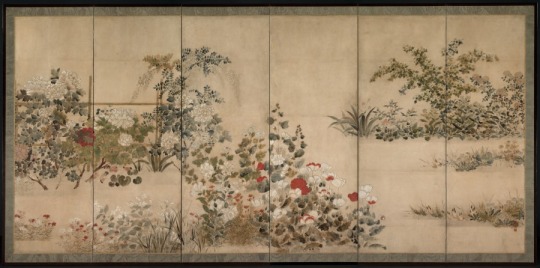
Flowers of the Four Seasons, Kitagawa Sōsetsu, mid-1600s, Cleveland Museum of Art: Japanese Art
Ascertaining the identity of the painter known as Kitagawa Sōsetsu from the first half of the seventeenth century remains an elusive but fascinating task. Unlike his more versatile predecessor Tawaraya Sōtatsu (died c. 1640), Sōsetsu painted only byōbu and hanging scroll compositions. While he did not collaborate with Kyoto's well-known calligraphers, book designers, or literary or court figures, attractive images such as appear on these byōbu were popular at the time, judging from the number of pieces that survive. In this respect, while his career is shadowy, it is much like those of the many well-regarded salon painters of the seventeenth and eighteenth centuries in Paris whose fame and identity have moved into and out of focus over the centuries.
Basically, the historical personage of Sōsetsu can be assessed in two ways. One view, his assumption at Sōsetsu's death to the position of master painter with the honorary Buddhist title Hōkkyō (Bridge of the Law), follows the normal course of events for promotion and the continued well-being of the master's studio. The other approach regards his paintings as aesthetically distinctive in their own right, giving credit to the clients and patrons of the Takagamine artists' colony founded by Sōsetsu and Hon'ami Kōetsu (1558-1637) as insightfully realizing a new generation of creativity and promoting its recognition. Whatever the theory, the most compelling documents for consideration are simply the many delightful paintings of annual flora that have tradition-ally been ascribed to Sōsetsu. Single hanging scroll compositions as well as sets predominate, although they tend to be in poor condition precisely because they were so well used as interior design elements. Many, moreover, have questionable seal impressions or no identifying seals at all. In a collaborative studio operation as successful as that of his predecessor Sōsetsu, the master's hand seldom emerges unequivocally, and Sōsetsu's assumption of that supervisory role is perhaps best considered by viewing the large intact floral compositions without weighty regard given to any seals present (in this instance a rounded Sōsetsu "Inen" seal, and square red "Sōsetsu" impression).
These byōbu are remarkable for their lack of ostensible décor. An airy composition and subtly controlled pools of wet ink describing variegated leaf forms characterize the pictorial attitude. Eschewing a gold-foil background, the artist composed islands of vegetation, which upon close inspection reveal an orchestrated succession of brushstrokes and carefully adjusted ink washes whose shapes identify a bewildering array of flowers categorized according to the passage of the seasons (beginning with spring on the right). No outlining brush-strokes define shapes. The only indications of ground are pale ink washes at the base of a floral group, and man's presence is denoted by a simple, plain wooden trellis supporting the wood peonies and young wisteria.
Unlike the seventeenth-century floral still-life painting tradition in Europe, this view of plant life has many perspectives, professes little interest in portraying objective reality or presenting overt painterly skills, and lacks any dazzling worldly goods to enhance its appearance. Comparison with Autumn Evening with Full Moon on Musashino Plain [2000.4.1-2] is instructive, revealing in its quiet artificiality an early, innovative Rinpa (school of Kōrin) approach to composition while suggesting age-old references to idealized garden of paradise settings in religious paintings. Ogata Kōrin (1658-1716) and his followers represent a further stage in the evolution of such imagery and references.
Size: Image: 153.7 x 329.2 cm (60 1/2 x 129 5/8 in.)
Medium: pair of six-fold screens; ink and color on paper
https://clevelandart.org/art/1968.193
41 notes
·
View notes
Photo

Poem from the Collection of Japanese Poems of Ancient and Modern Times (Kokin wakashū), Hon'ami Kōetsu, early 1610s, Minneapolis Institute of Art: Japanese and Korean Art
four lines of calligraphy of varying sizes on silver paper with ivy leaves in gold Poem 289, SKS
Size: 7 1/4 × 6 7/16 in. (18.42 × 16.35 cm) (image) 48 1/16 × 15 3/4 in. (122.08 × 40.01 cm) (mount, without roller )
Medium: Ink and gold on silver-decorated paper
https://collections.artsmia.org/art/122145/
11 notes
·
View notes
Photo
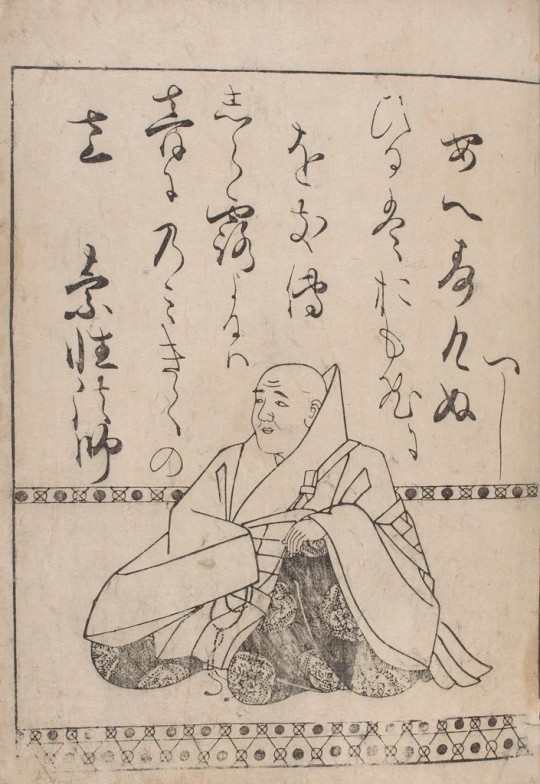
Poet Sosei Hōshi (Priest Sosei) from page 3A of the printed book of "Thirty-Six Immortal Poets" (Sanjūrokkasen), Kōetsu edition, Hon'ami Kōetsu, Momoyama period, published circa 1610, Harvard Art Museums: Prints
Harvard Art Museums/Arthur M. Sackler Museum, Bequest of the Hofer Collection of the Arts of Asia
Size: H. 34.5 cm x W. 24.1 cm (13 9/16 x 9 1/2 in.)
Medium: Page 3A of a thread-bound woodblock-printed book with paper cover; ink on paper
https://www.harvardartmuseums.org/collections/object/187363
4 notes
·
View notes
Text

Poem by Kamo no Chōmei with Underpainting of Cherry Blossomsdated 1606
Calligraphy by Hon'ami Kōetsu
7 notes
·
View notes
Photo
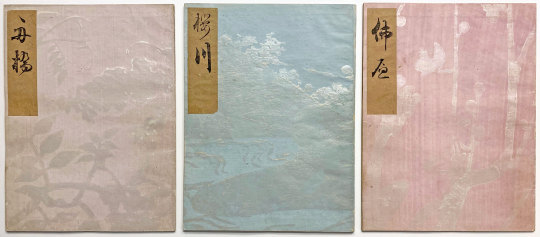

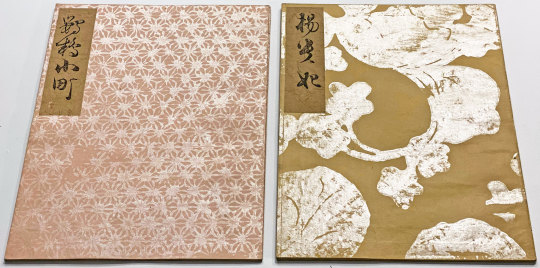
Kōetsu utai-bon (Nō libretto) [Saga, Kyoto, 1607] [Japan, Edo period, early 17th century] [National Museum of Asian Art, Smithsonian Institution, Washington, D.C.]
#art#calligraphy#visual writing#drawing#pattern#book#cover#book cover#tawaraya sōtatsu#hon'ami kōetsu#national museum of asian art#smithsonian institution#1600s
38 notes
·
View notes
Text
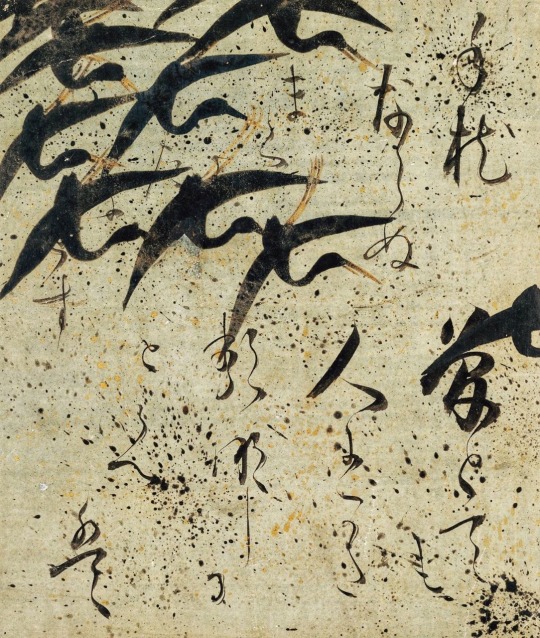
Attributed to Tawaraya Sōtatsu (act. 1600-1640),
Calligrapher Hon'ami Kōetsu (Japanese, 1558 - 1637):
— Flying Cranes and Poetry.
Edo Period. Japanese Poem sheet (shikishi) mounted as a hanging scroll, ink and gold on paper. Nelson-Atkins Museum of Art.
1K notes
·
View notes
